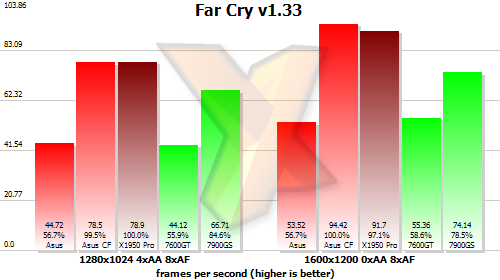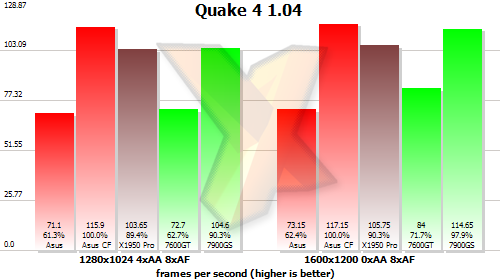Gaming results and HEXUS.bang4buck

In Far Cry, the Asus X1650XT achieves broadly similar performance to a GeForce 7600GT. But the 7900GS, which is less than £10 more expensive, is significantly quicker. You get a nice boost from running two cards in CrossFire mode - around 75 per cent. But a single X1950 Pro isn't far off, and won't cost you anywhere near as much as two X1650XTs.

Quake 4 favours Nvidia, particularly at higher resolutions. Although the Asus X1650XT performs around the same as the 7600GT at 1,280 x 1,024 with 4x AA and 8x AF, the GeForce 7600GT cruises ahead at 1,600 x 1,200 with 0x AA and 8x AF - and the 7900GS is way ahead at both resolutions. Whilst running two X1650XTs in CrossFire mode pushes the card to the top of the pile, with a single 7900GS not far behind this is hardly a value option.

Again, the Asus X1650XT is almost level pegging with the cheaper Nvidia GeForce 7600GT. It beats it at 1,280 x 1,024 with 4x AA and 8x AF, but the scores are effectively identical at 1,600 x 1,200 with 0x AA and 8x AF. The GeForce 7900GS shows it a clean set of heals at either resolution, but at least the benefits of CrossFire are very clear, even over the X1950 Pro.

HDR is clearly not the X1650XT's forte, thanks to its 128-bit memory interface. The GeForce 7600GT beats it at either test resolution, and we wouldn't recommend playing Splinter Cell: Chaos Theory above 1,280 x 1,024 with HDR. Indeed, only the Radeon X1950 Pro and GeForce 7900GS are worth trying at 1,600 x 1,200. And if you bought two X1650XTs for HDR, you would have wasted your money considering the miniscule frame-rate benefits on offer in this quality mode. We've noticed that ATI's internal CrossFired cards struggle in this test; a driver bug, perhaps?
Performance summary
Although the X1650XT is not a bad performer, and a distinct improvement over the X1650 PRO, it's hardly anything to write home about when lesser Nvidia GeForce cards offer essentially the same abilities for less.HEXUS.bang4buck
For a very rough assessment of the card's value, we've aggregated the average frame rates for the three games at 1280x1024, the likely display resolution for midrange PCs equipped with these cards, and researched the cards' current average street prices. We've then used these to derive a metric of performance versus cost - or bang for buck, as the hip young people like to call it these days. Clearly, this is a very rough evaluation of value and doesn't take into account premium features like HDCP support or other architectural benefits. But for a very easy to understand view of how much gaming you get for your money, it's a good place to start, and in this case tells us quite a bit about how the EAX1600XT compares to similarly priced competitors.
It's pretty clear that Asus's EAX1650XT is not great value. At the low end, Nvidia's GeForce 7600GT offers similar performance for around £10 less. If you've got a little more cash, either a GeForce 7900GS or Radeon X1950 Pro will offer better value as well, with the Nvidia card just slightly ahead. Running two X1650XTs in CrossFire mode is even worse value.









